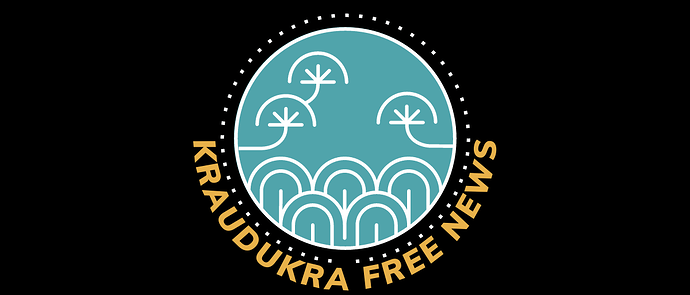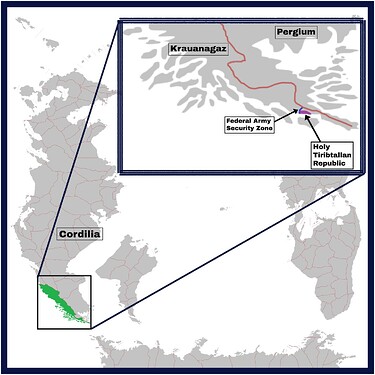Cautious Optimism in Kevpríg as War Crimes Hearings Begin: Inside the Holy Tiribtallan Republic
Alkantara, Kevpríg— Eight months after its establishment, the Holy Tiribtallan Republic (HTR) has begun to show signs of stability and resilience, surprising many observers who doubted the viability of the semi-autonomous zone in Southwestern Kevpríg. Initially hampered by logistical challenges and limited resources, the HTR has since grown into a key partner in both peacebuilding and disaster recovery efforts across southern Krauanagaz.
The turning point came in early spring, following a series of devastating natural disasters that struck southern Cordilia. While the Krauanagaz Federation and international agencies mounted a large-scale relief operation, the HTR’s leadership mobilized local militias, civil society networks, and religious institutions to provide aid at the community level. Their grassroots relief operations, centered in the regional capital of Tirtallaza, earned praise from residents and humanitarian organizations alike. “They were the first to arrive in some of the hardest-hit villages,” said one aid worker. “It showed that the Red K-MOT coalition could function as more than just a military authority.”
Since then, the HTR has focused on consolidating its governance structures. Schools in Tirtallaza and surrounding towns reopened in mid-July with expanded enrollment, supported by teachers seconded from Kevpríg’s Education Department. Clinics that once stood half-empty are now receiving medical supplies via new transport routes agreed upon in coordination with federal authorities. Although unemployment remains high, the launch of small-scale reconstruction projects, especially road and bridge repairs, has created jobs and helped reconnect rural communities.
Politically, the HTR’s leadership has adopted a more conciliatory tone. The Red K-MOT administration has permitted limited opposition activity and held local consultative councils in August, drawing participation from village elders, women’s groups, and youth associations. While critics caution that true democracy is still distant, these forums have been recognized as an important step toward inclusivity.
President Thalira Renkara recently praised the HTR’s role in post-disaster recovery during a visit to Kevpríg, calling the zone “a living experiment in reconciliation.” International observers from the World Forum echoed this sentiment, noting that reports of armed clashes have sharply declined since last December.
Despite these positive developments, some challenges remain. The HTR continues to struggle with poverty, and long-term investment has yet to materialize at the scale promised. Some residents remain wary of Red K-MOT’s intentions, fearing that the alliance may revert to heavy-handed tactics if its authority is threatened. Yet for now, the mood in Tirtallaza is cautiously optimistic.
As one local shopkeeper put it, “For years we only knew war and uncertainty. Now, we have schools reopening, new roads, and children playing again in the streets. It is not perfect, but it feels like peace.”
Meanwhile in Yayyára, one of the most sensitive provisions of the landmark peace agreement that created the Holy Tiribtallan Republic is now unfolding. That is the prosecution of senior leaders of Red K and the Messengers of Tallaz (MOT) for crimes committed during years of insurgency in Kevpríg. While the pact granted broad clemency to rank-and-file fighters in both groups, a step seen as essential to disarmament and reintegration, it explicitly required the indictment of top commanders accused of atrocities.
The trials, held in a specially convened tribunal in Yayyára, have drawn both local and international attention. Prosecutors have focused on cases of mass civilian displacement, destruction of villages, and targeted killings that occurred in the height of the conflict between 2021 and early 2024. Evidence includes survivor testimony, captured communications, and documentation from humanitarian monitors who operated during the conflict.
The first hearings began in August, with five senior commanders from Red K and MOT on trial. Among them, Aruélan Dethik, a Red K strategist accused of orchestrating attacks on refugee columns during the 2022 Kevpríg campaigns. MOT leader Varneth Azaari, once considered untouchable, faces charges of ordering the execution of rival Tiribtallan religious figures who opposed militant rule. Both men have denied wrongdoing, portraying the prosecutions as “victor’s justice.”
Krauanagazan federal officials, who insisted on the tribunal as part of the peace framework, have emphasized that the trials are not about revenge but accountability. “The people of Kevpríg deserve the truth and a measure of justice,” said Attorney General Enri Veyalan, who is overseeing the federal liaison team. International observers from the World Forum Human Rights Commission are monitoring proceedings to ensure fairness.
Reactions among residents have been mixed. Some victims’ families view the trials as a long-awaited chance for closure. “We want to see those who gave the orders answer for what they did,” said a farmer from southern Kevpríg whose village was destroyed in 2023. Others express skepticism, noting that many lower-level fighters who directly carried out attacks have been released under the clemency deal. “Justice feels partial,” remarked one widow in Kalaígarziórkald, on the T’lai Peninsula.
The leadership of the Holy Tiribtallan Republic has remained cautious in its public statements. While officially cooperating with the tribunal, HTR administrators have urged citizens to view the process as a step toward reconciliation rather than division. “We must face our past, but also move forward,” said an HTR council spokesperson in September.
The trials are expected to last another several months, with further indictments possible as investigators sift through wartime records. For Krauanagaz and the HTR alike, the proceedings will test whether the promise of peace through accountability can endure without reigniting old animosities.

